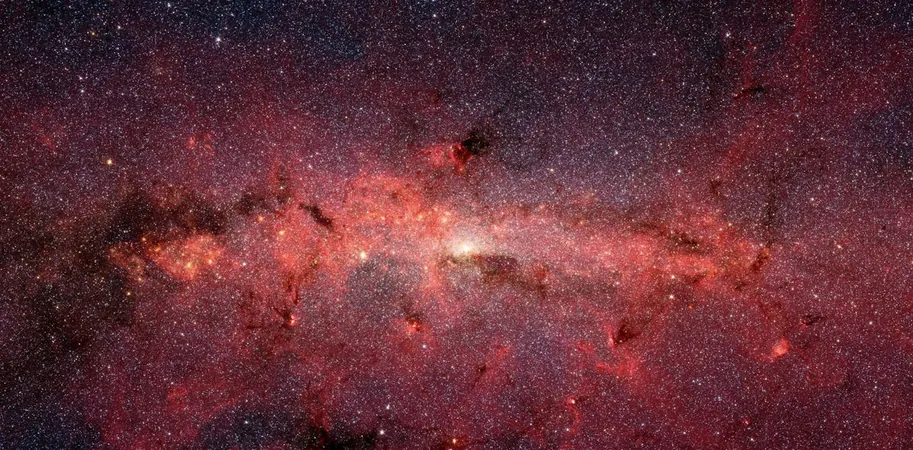
Is Dark Matter Finally Unveiling Its Secrets? New Insight into the Milky Way's Mysteries!
2025-04-16
Author: Mei
A Galactic Enigma Unraveled
For decades, astronomers have been baffled by two intriguing phenomena lurking in the heart of our Milky Way galaxy. In the central molecular zone (CMZ), a chaotic hub near the galaxy's core, gas is becoming ionised at a surprisingly accelerated rate, raising eyebrows across the scientific community.
In addition, a curious gamma-ray glow has been detected, pulsating at an energy of 511 kilo-electronvolts (keV), a signature linked to the annihilation of electrons and their antimatter twins, positrons. Despite numerous theories, the sources of these baffling occurrences have remained a mystery—until now.
Could Dark Matter Hold the Key?
In a groundbreaking study recently published in Physical Review Letters, researchers propose a revolutionary connection between these two phenomena and dark matter—an elusive cosmic ingredient that constitutes about 85% of the universe’s mass but remains undetectable through conventional means.
The theory suggests a new, lighter form of dark matter, less massive than previously theorized particles, could be playing a critical role in these galactic mysteries. This notion opens exciting doors for understanding our universe.
Unlocking the Secrets of the CMZ
The CMZ, spanning nearly 700 light-years, houses some of the densest molecular gas in our galaxy. Observations reveal an unexpected rate of ionization, where hydrogen molecules are split into charged particles at a speed that standard cosmic rays and starlight fail to justify.
This phenomenon compels scientists to ask: Could there be a shared hidden process at work?
A Hypothesis of Light Dark Matter
What if dark matter is not just heavy and dense but also incorporates very light particles? Researchers highlight the possibility of sub-GeV (giga electronvolt) dark matter candidates that can interact with their antiparticles, potentially leading to the creation of electrons and positrons during annihilation events.
In the dense CMZ environment, these newly formed particles might efficiently ionize surrounding hydrogen by knocking off their electrons, aligning precisely with the observed ionisation levels.
Gamma Rays: The Final Link?
If these dark matter interactions do generate positrons, the cascading annihilation events could very well account for the mysterious 511keV gamma-ray emissions. This connection provides an alluring clue, suggesting the origins of both the ionization rates and the enigmatic glow could indeed stem from the same source: light dark matter.
Testing the Unseen
In this groundbreaking research, the ionization profile predicted from dark matter merges strikingly with observed data. A smoothly distributed dark matter halo aligns more accurately with the uniform ionization seen rather than localized sources like black holes or supernovae.
As future telescopes enhance their resolution, they may unveil new insights into the spatial relationships between the gamma-ray emissions and the ionization rate, further clarifying the dark matter puzzle.
A Glimpse into the Cosmic Future
These observations serve as a reminder that the universe is brimming with mysteries waiting to be uncovered. The strange signals emanating from the vibrant center of our galaxy invite us to look deeper, revealing hints of cosmic elements we have yet to understand.
Stay tuned as we continue to explore these revelations, because the secrets of dark matter may very well reshape our understanding of the cosmos!




 Brasil (PT)
Brasil (PT)
 Canada (EN)
Canada (EN)
 Chile (ES)
Chile (ES)
 Česko (CS)
Česko (CS)
 대한민국 (KO)
대한민국 (KO)
 España (ES)
España (ES)
 France (FR)
France (FR)
 Hong Kong (EN)
Hong Kong (EN)
 Italia (IT)
Italia (IT)
 日本 (JA)
日本 (JA)
 Magyarország (HU)
Magyarország (HU)
 Norge (NO)
Norge (NO)
 Polska (PL)
Polska (PL)
 Schweiz (DE)
Schweiz (DE)
 Singapore (EN)
Singapore (EN)
 Sverige (SV)
Sverige (SV)
 Suomi (FI)
Suomi (FI)
 Türkiye (TR)
Türkiye (TR)
 الإمارات العربية المتحدة (AR)
الإمارات العربية المتحدة (AR)